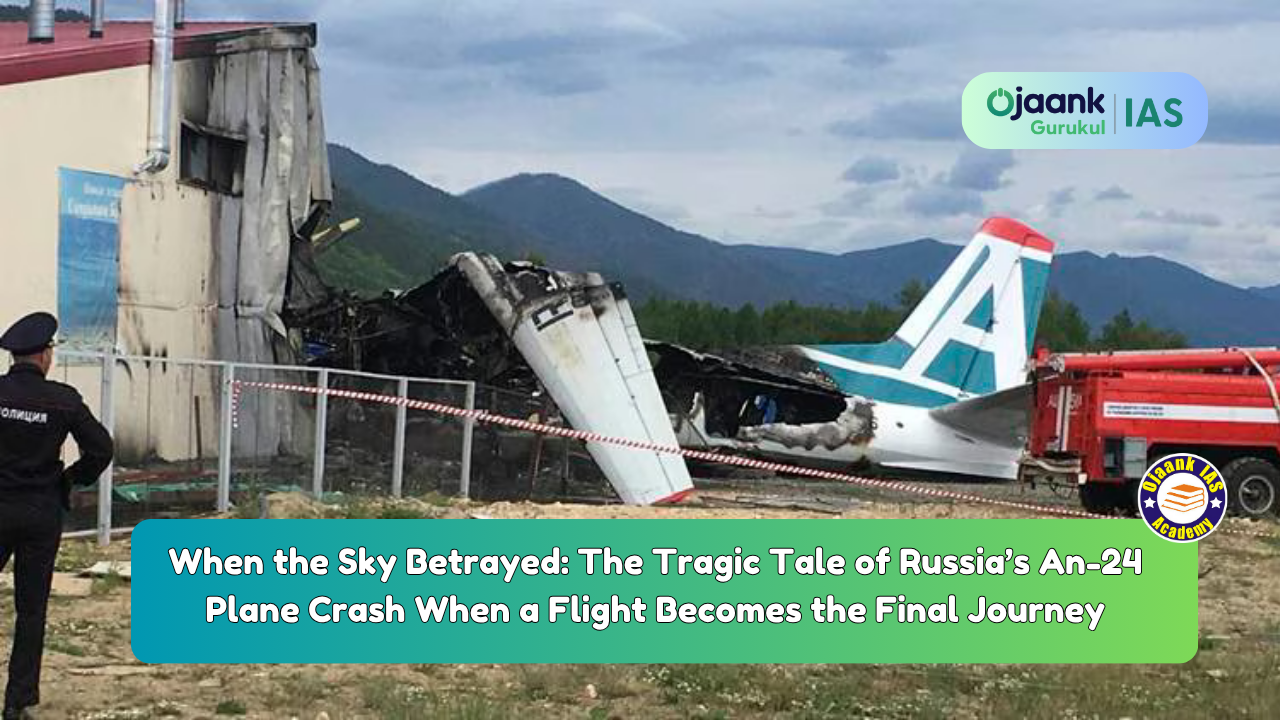When the Sky Betrayed: The Tragic Tale of Russia’s An-24 Plane Crash When a Flight Becomes the Final Journey

When a Flight Becomes the Final Journey
On the morning of July 24, 2025, the air was unusually heavy in Tynda, a remote town in Russia’s Amur region. A nearly 50-year-old Soviet-era aircraft, the An-24, was on its final journey in the skies above Siberia. This Angara Airlines flight was operating on the Khabarovsk–Blagoveshchensk–Tynda route when it suddenly disappeared from radar during preparations for landing at Tynda. A few hours later, the burnt wreckage was discovered scattered across a hillside, with no survivors.
Core Issue: A Collapsing Aviation Safety Infrastructure
This crash wasn’t merely a technical or weather-related mishap but rather a glaring indicator of a complex aviation system collapsing. Several questions arise:
-
Should a 50-year-old aircraft have been allowed to fly?
-
Were the weather warnings sufficient?
-
Most critically, was this simply a case of "crew error," or something deeper—a systemic failure?
Historical Background: Soviet Aircraft, Modern Russia's Responsibility
The An-24 was designed in the 1960s by Antonov Design Bureau, intended for connecting remote regions with limited runway facilities. However, the fact that this particular aircraft, built in 1976, was still in active service in 2025 reflects the stark irony of Russia’s aviation safety culture. Globally, most countries have retired or placed such old aircraft in museums.
Current Scenario: Ignored System Warnings
The aircraft took off from Blagoveshchensk, heading towards Tynda, a challenging area close to the Chinese border known for severe weather conditions.
-
📍 Wreckage: Found 16 km away from Tynda in mountainous terrain
-
📶 No distress call was issued
-
🌫️ Dense taiga and marshlands severely impeded rescue efforts
-
🔥 Burnt fuselage indicated the aircraft caught fire during the crash
Conflicting passenger data:
| Source | Passengers | Crew | Children | Total Estimated |
|---|---|---|---|---|
| TASS | 43 | 6 | 5 | ~50 |
| Emergency Svcs | 40 | 6 | 2 | ~46 |
| Governor | 43 | 6 | 5 | ~49 |
Primary Cause: Crew Error or Systemic Negligence?
According to TASS, the primary cause was cited as "crew error during poor visibility landing." However, an underlying question remains—could this error have been prevented?
-
🚨 No warnings before radar disappearance
-
🛠️ Russian aviation safety authority Rostransnadzor had inspected the aircraft in July 2025
-
🛬 Crash occurred during landing preparations
Stakeholders' Roles: Who is Responsible?
-
Angara Airlines
-
Did they adequately service the 50-year-old aircraft?
-
Were pilots fully briefed on weather conditions?
-
-
Russian Government and Regulatory Agencies
-
Was Rostransnadzor’s inspection merely procedural?
-
Is government oversight adequate?
-
-
Passengers and Their Families
-
Were passengers informed of the aircraft’s age?
-
This incident has severely shaken their trust in the airline and the aviation system.
-
Global Comparison: Do Other Countries Fly Such Old Aircraft?
| Country | Avg. Maximum Aircraft Age | Still Flying Such Old Planes? |
| USA | 11 years | No |
| Germany | 10 years | No |
| India | 8–12 years | No (An-24 retired) |
| Russia | 18–25 years | Yes, including An-24 |
According to ICAO, an aircraft’s operational life depends on maintenance and avionics upgrades. However, using modern software on a 50-year-old aircraft is essentially clinging to false hope.
Challenges and Criticisms:
-
Lack of Transparency: Public not informed about the age of operational aircraft.
-
Delayed Investigation Processes: Reports on Russian aviation incidents often delayed by years.
-
Low Investment in Remote Regions: Areas like Tynda require better runways, weather stations, and ATC systems.
-
Airline Lobbying and Exceptions: Airlines often cut corners to reduce operational costs.
Expert Opinions:
-
Igor Deltsin, Russian aviation analyst: "This wasn’t an accident; it was a 'scheduled disaster.' Sending a 50-year-old aircraft into bad weather is inviting tragedy."
-
William Taylor, ICAO auditor: "Russia must fully digitize aviation monitoring in remote regions and ground all aircraft older than 30 years."
Reforms and Potential Solutions:
-
✅ Mandatory retirement policy for aircraft over 50 years
-
✅ Weather-based landing clearance mandatory before flights
-
✅ GPS-based ATC networks for remote locations
-
✅ Mandatory updated visibility and control training for pilots
-
✅ Mandatory public release of accident investigation reports
-
✅ Retire and relocate aircraft like the An-24 to museums
Conclusion: A Flight Turned into a Warning
An aircraft symbolizes trust more than machinery. When trust transforms into charred debris, it isn't just an accident but a reflection on national safety standards. The Angara Airlines crash shook Russia’s aviation foundations, transforming lives and dreams into painful statistics.
Five Key Takeaways:
-
🛑 The 50-year-old An-24 proved helpless against technical and weather challenges.
-
📉 Crew error cited, but aging infrastructure and visibility played significant roles.
-
🌫️ Dense forests and adverse weather hindered rescue operations.
-
🔍 Russian aviation oversight and transparency face serious questions.
-
✈️ Countries like Russia must reconsider flying such outdated aircraft.
-1753179287671.png)